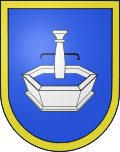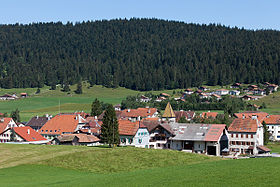La Brévine
| La Brévine | |
|---|---|
| State : |
|
| Canton : |
|
| District : | No district division |
| BFS no. : | 6432 |
| Postal code : | 2406 |
| Coordinates : | 536 726 / 203768 |
| Height : | 1043 m above sea level M. |
| Height range : | 1023–1308 m above sea level M. |
| Area : | 41.81 km² |
| Residents: | 630 (December 31, 2018) |
| Population density : | 15 inhabitants per km² |
| Website: | www.labrevine.ch |
|
View of La Brévine |
|
| Location of the municipality | |
La Brévine is a municipality in the canton of Neuchâtel in Switzerland .
geography
La Brévine is 1043 m above sea level. M. , 24 kilometers west of the canton capital Neuchâtel (linear distance ). The farming village extends in the flat area of the high valley Vallée de la Brévine in the Neuchâtel Jura , on both sides of the village stream Le Bied , near the border with France .
The area of the 41.8 km² municipal area includes the central and western part of the synclines of the Vallée de la Brévine with the Lac des Taillères, which has no drainage above ground . In the south, the municipality extends to the heights of Les Fontenettes ( 1242 m above sea level. M. ) and Crêt du Cervelet , on the 1308 m above sea level. M. the highest point of La Brévine is reached. The northern border runs on the wooded ridge of the Armont , which is up to 1266 m above sea level. M. increases. In the far west, the area extends in a narrow tip over the height of the Bois des Vaux ( 1220 m above sea level ) into the catchment area of the Doubs and up to the Rochers du Cerf ( 1195 m above sea level ). On the heights south of the Vallée de la Brévine there are extensive Jura high pastures with the typical mighty spruce trees , which either stand individually or in groups. In 1997, 2% of the municipal area was in settlements, 43% in forests and woodlands, 53% in agriculture and a little more than 2% was unproductive land.
La Brévine includes the hamlets of Le Brouillet ( 1060 m above sea level ) and Bémont ( 1050 m above sea level ) in the south-western Vallée de la Brévine, Les Taillères ( 1055 m above sea level ) north of Lac des Taillères, La Chatagne ( 1056 m above sea level ) east of La Brévine on the edge of the Marais de la Chatagne and numerous individual farms scattered across the high valley and the Jura heights. Neighboring municipalities of La Brévine are Val-de-Travers , Les Ponts-de-Martel , La Chaux-du-Milieu and Le Cerneux-Péquignot in the canton of Neuchâtel as well as Grand'Combe-Châteleu , Les Gras , Ville-du-Pont and Hauterive- la-Fresse in neighboring France .
climate
La Brévine is characterized by a harsh and relatively humid climate. In winter, in the completely closed Vallée de la Brévine, a lake of cold air forms during nights of radiation (clear sky and little to no wind ensure maximum cooling of the ground via radiation). Temperatures of −30 ° C are not infrequently reached, which is why the place is named Siberia of Switzerland . On January 12, 1987, at the La Brévine measuring station, the lowest temperature ever recorded at an official MeteoSwiss station was recorded at −41.8 ° C.
Climate table
| La Brévine, 1981-2010 | ||||||||||||||||||||||||||||||||||||||||||||||||
|---|---|---|---|---|---|---|---|---|---|---|---|---|---|---|---|---|---|---|---|---|---|---|---|---|---|---|---|---|---|---|---|---|---|---|---|---|---|---|---|---|---|---|---|---|---|---|---|---|
| Climate diagram | ||||||||||||||||||||||||||||||||||||||||||||||||
| ||||||||||||||||||||||||||||||||||||||||||||||||
|
Average monthly temperatures and rainfall for La Brévine, 1981–2010
Source:
|
||||||||||||||||||||||||||||||||||||||||||||||||||||||||||||||||||||||||||||||||||||||||||||||||||||||||||||||||||||||||||||||||||||||||||||||||||||||
population
| Population development | |
|---|---|
| year | Residents |
| 1750 | 1220 |
| 1850 | 1339 |
| 1880 | 1703 |
| 1900 | 1494 |
| 1950 | 1008 |
| 1960 | 876 |
| 1970 | 783 |
| 1980 | 654 |
| 1990 | 626 |
| 2000 | 647 |
| 2005 | 703 |
With 630 inhabitants (as of December 31, 2018), La Brévine is one of the smaller communities in the canton of Neuchâtel. 95.2% of the residents are French-speaking, 3.4% German-speaking and 0.6% Portuguese-speaking (as of 2000). The La Brévine valley was comparatively densely populated in the 18th and 19th centuries. After the peak around 1880, a population decline of more than 60% was recorded due to strong emigration, which has only been slowed down and stopped in recent years.
politics
The voting shares of the parties in the 2015 National Council election were: SVP 48.7%, FDP 21.8%, SP 11.3%, PdA 10.0%, GPS 4.1%, CVP 2.8%, glp 0.4 %, BDP 0.2%.
economy
La Brévine was an agricultural village until the 19th century . In the 18th century, spinning and lace making were introduced at home. In the course of the 19th century, this branch of business was replaced by watchmaking , which brought the valley an economic boom. Since the 18th century peat was cut in the bog areas of the Vallée de la Brévine . Today peat mining has stopped. The only industrial company is a watch factory. Agriculture is still very important, around 50% of the workforce is employed in the primary sector. Cattle breeding and dairy farming (cheese production) predominate , there is also timber trade.
traffic
The community is far away from the major thoroughfares on the cantonal road from Le Locle to Fleurier . La Brévine is connected to the public transport network by three post bus lines (to Le Locle, Fleurier and Les Bayards).
tourism
The region of La Brévine is a destination for nature lovers and those seeking relaxation. In summer, the Jura heights invite you to take long walks and hikes. The flat Vallée de la Brévine is ideal for cross-country skiing in winter.
The mineral springs of La Chatagne and Bonne-Fontaine, discovered in the middle of the 17th century, were used for cures until the end of the 19th century.
history
The Vallée de la Brévine was reclaimed by settlers from the Val de Travers from the 13th century . During the 14th century, emigrants from Burgundy immigrated . The etymology of the name La Brévine is controversial. Some sources indicate him as the word modification abreuvoir ( potions ), while others attribute it to the Celtic Bebrona back the Biberbach means. The first hamlet mentioned in a document is Bémont (1266 Bemont), Les Taillères is also mentioned as early as 1304 ( Chaul de Estaleres ).
After settlers from Le Locle and La Sagne had immigrated in the course of the 16th century , the valley came under the influence of the Valangin rule . Until 1624 La Brévine belonged to Kastlanei Val de Travers, after which it became a separate municipality with a Mairie and civil court, which was only dissolved in 1848. The name La Brévine was initially only valid for the central town, it was only in the 18th century that it was extended to the entire current municipal area. In 1831 numerous houses fell victim to a fire.
The sovereignty of La Brévine was held by the county of Neuchâtel, which became a principality in 1648 and was linked to the Kingdom of Prussia from 1707 through a personal union. In 1806 the area was ceded to Napoleon I and came to the Swiss Confederation in the course of the Congress of Vienna in 1815 , whereby the kings of Prussia until the Neuchâtel trade in 1857 also remained princes of Neuchâtel.
Attractions
The Reformed Church of La Brévine was built in 1604 and restored before its 400th birthday in 2003. The village, previously dependent on Le Locle, has had its own parish since 1622. In the village and in the hamlets there are numerous characteristic farmhouses of the Upper Jurassic from the 17th to 19th centuries. There is a chapel in Bémont.
Personalities
- Raymond Clottu (* 1967), politician, lives in La Brévine
photos
Web links
- Official website of the municipality of La Brévine (French)
- Olivier Girardbille: Brévine, La. In: Historical Lexicon of Switzerland .
Individual evidence
- ↑ Permanent and non-permanent resident population by year, canton, district, municipality, population type and gender (permanent resident population). In: bfs. admin.ch . Federal Statistical Office (FSO), August 31, 2019, accessed on December 22, 2019 .
- ↑ Federal Office for Meteorology and Climatology : Records and Extreme. Retrieved January 12, 2019 .
- ↑ Climate table. In: meteoschweiz.admin.ch. meteoschweiz, accessed on July 28, 2018 .
- ^ Election du Conseil National du October 18, 2015, Résultats des partis - Les suffrages. (aspx) (No longer available online.) Chancellerie d'État neuchâtelois, October 18, 2015, archived from the original on November 1, 2015 ; Retrieved October 30, 2016 (French). Info: The archive link was inserted automatically and has not yet been checked. Please check the original and archive link according to the instructions and then remove this notice.











